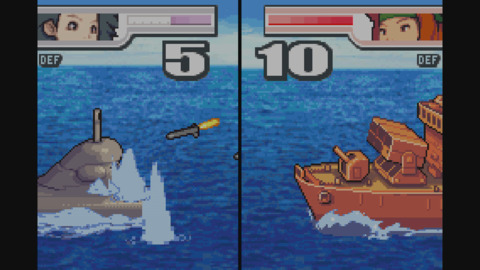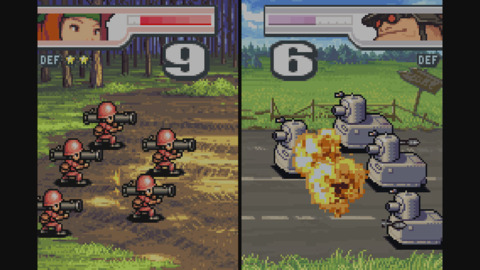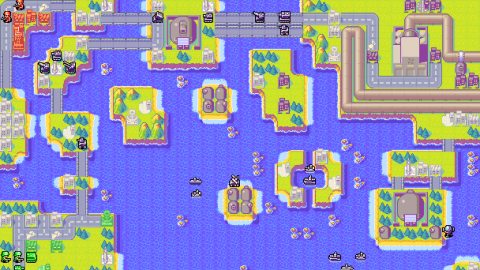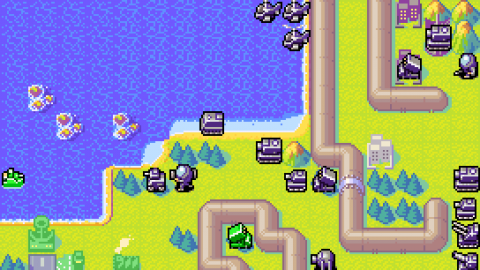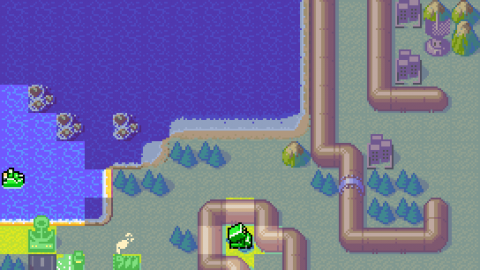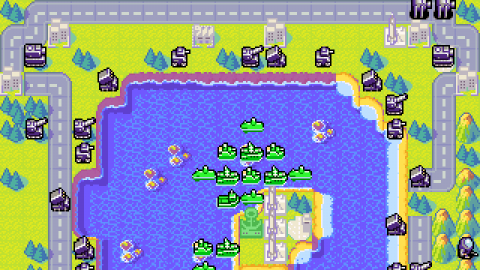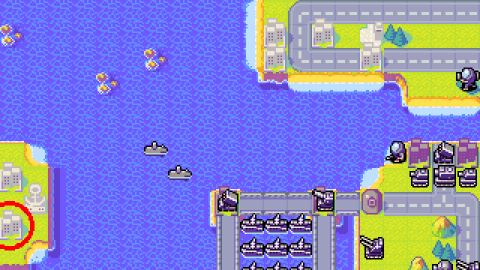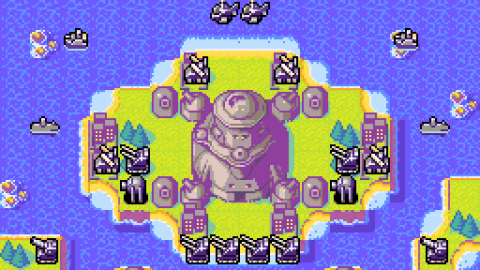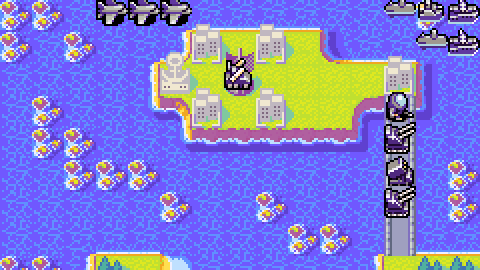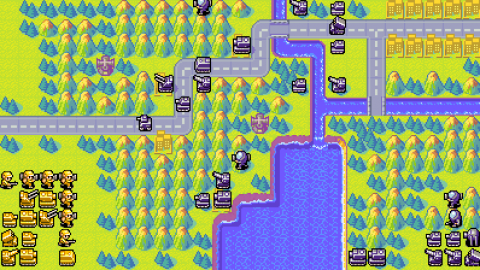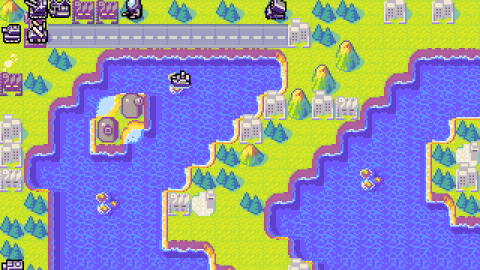Overview
Advance Wars 2: Black Hole Rising is a tactical turn-based strategy game developed by Intelligent Systems and originally released for Game Boy Advance in 2003. As with Nintendo's prior "Wars" titles, Advance Wars 2 features strategic military-themed gameplay presented in a playful tone and supported by a lively cast of colorful characters. Players command four different allied factions over the course of the story campaign in an effort to defend the Macro Land region of "Wars World" from a new invasion by the aggressive Black Hole Army.
Like the first Advance Wars on GBA, this game was never released as a standalone title in Japan. However, it was eventually made available in Japan in 2005 as part of the Game Boy Advance Wars 1+2 compilation.
Story
As the Allied Nations recover from the war that ravaged Cosmo Land, the recently defeated Black Hole Army has mysteriously regrouped and launches an all out assault on Macro Land. Lead by Sturm, each nation was besieged by a new Black Hole commanding officer. As Orange Star, Blue Moon, Yellow Comet, and Green Earth slowly repels the invading forces under the command of Flak, Lash, Adder, and Hawke, Macro Land countries band together for a final assault on Sturm's headquarters. The Black Hole Army's final gambit is a missile that if activated could destroy half of Wars World. The Nations' Armies surround the compound and destroy the Death Ray guarding the facility, but Sturm attempts to self destruct the missile. Andy rushes in to stop Sturm but falls short; Hawke kills Sturm, stops the detonation and pronounces himself as Black Hole's new leader. Hawke takes the few remaining forces of the Black Hole Army out of Macro Land along with Flak, Lash, Adder, and Hawke. Wars World is again safe for now.
Gameplay
Players command their forces in a turn based fashion on a map grid, using each turn to spend funds on requisitioning new forces and placing their armies in specific locations. Factors such as cover, fog of war, and resources are all important to the flow of the game. Cities can bring in revenue for the army while Ports, Factories, and Airports all are capable of deploying new forces to the battlefield. In addition, if wounded units stop on a city under his or her own control, the units can be healed slightly for a small fee.
Other terrain elements such as forests and mountains can provide more protection and give greater line of sight at the cost of being difficult or impossible to travel over for wheeled vehicles. Fog of war enables players to block enemy movement, for if any unit runs into an enemy unit hidden in the fog, their movement is stopped until the next turn.
Resources such as ammunition and fuel are required to continue the fight. A unit without ammunition must use their secondary (less efficient) weapon or, if lacking one, will be unable to fight. A land unit without fuel cannot move; naval and air units will simply sink or crash and be lost forever.
Certain units also have special abilities and can deal more damage to specific types of units; as such, there is a rock-paper-scissor mechanic in the game that requires the player to be knowledgeable on how to approach the enemy. A round is won when one team has captured the enemy headquarters with infantry or has successfully routed the enemy from the map.
Combat
All units start out with 10 HP when built or trained. When two units engage in battle, in an equal fight, the attacking force always deals more damage than the defending force.
The key phrase there is "equal fight." Unit weapons and types greatly play a factor into how much damage can be dealt out and can determine how effective the counterattack is. For example, infantry battling other infantry are more effective than infantry going up against tanks.
Advance Wars has two types of attack on offer in the game:
Direct combat encompasses most of the units in the game such as tanks and infantry. During this combat, the attacking force will deal the first blow while the survivors from the attack can return fire. The advantage of direct combat is that units can move to the opponent and initiate combat.
Indirect combat is only specific for artillery units and battleships in the game. With this combat, the attacking force deals damage without reprisals from the enemy. Indirect combat requires that the artillery unit attack from their current position, so the units must be in position and have a target in range. Thus, indirect combat units cannot attack and move in the same turn.
Unit Production
Usually most levels involve the necessity to produce units from ports, airports, or bases. At the beginning of each turn, the player receives income from all the properties owned and can spend money on new units. Ground units are built from bases, ships are built out of naval ports, and air units are built at the airport. The game enforces a fifty unit cap, but most games do not span a length long enough to reach the cap.
Properties and Terrain
Each tile on the map has a distinct advantage that will require smart players to know and master these battlefield conditions. Roads are the easiest to traverse on but offer zero stars of defense, making it only useful for fast transportation usually by wheeled vehicles. Plains have one star of protection to give to forces and also allows for faster travel than most tiles. Woods can hide units in fog of war games and give two stars of defense and are usually great spots for artillery to hide in. Properties all offer three stars of defense and can heal wounded units if under player control. Lastly, mountains and headquarters are the most beneficial defense plots of land, giving four stars of defense.
Each property, by default, gives 1000 G per turn unless modified in versus mode. These properties include the following list below, with any special abilities described:
City: Heals ground units and brings in income.
Base: Can produce and heal ground units only.
Airport: Can produce and heal air units only.
Port: Can produce and heal naval units only.
Rocket Silo: Fires one rocket that strikes a diamond pattern (with the horizontal and vertical axis range being 5 squares), dealing three damage per units affected.
Weather
Like a real battle, weather plays a critical factor in Advance Wars. In snow, units suffer a movement reduction and air and sea units use up more fuel as long as the conditions persist. In rain, unit vision suffers and movement through certain terrains are increased.
Units
Below are a list of all the units in the game with a short description of each and price needed for production.
Ground Units
Infantry: Armed with rifles, infantry are one of the only two units in the game who can capture properties such as cities and climb into mountains for extra sighting in Fog of War games. For only 1000 G, infantry are a crucial part of the early game as they are imperative to starting the economy and early scouting. Infantry are only effective against other infantry or mechs, as their rifles are not useful against armored units. Range: Direct; Movement: 3 squares. Can travel through forests without penalty; over streams and mountains with slight penalty
Mechs: Armed with bazookas and rifles as a secondary, mechs are the other unit that can capture properties. Priced at 3000 G, their bazookas are very efficient at eliminating armored units while their rifles can be used against enemy foot soldiers. Mechs cannot move as fast as their infantry counterparts due to the extra weaponry they carry, so they are not as good in taking properties, and do not have a lot of ammo for the bazookas but are still very powerful grounds forces to contend with. Range: Direct; Movement: 2 squares. Can travel through forests without penalty; over streams and mountains with slight penalty
Recon: Essentially jeeps mounted with machine guns, recon units are important for early scouting as they have the highest vision of any unit in the game. They also can travel a great distance on roads but suffer when traversing through woods. For Fog of War games, they serve as spotters for artillery units and their machine guns can take care of infantry and weakened mech units. For 4000 G, these units are an essential part of any army. Range: Direct. Movement: 8; tires limit off-road movement
APC: APCs have no attack to speak of, but their role goes beyond troop transport. Priced at 5000 G, APCs are the only unit in the game who can resupply units with fuel, rations, and ammunition. These armored vehicles also can travel on most terrain with no problem and can transport one infantry unit in its holds. Movement: 6 squares
Tank: The tank, armed with a cannon and machine gun, serves as the light tank in the game, doing solid damage against lighter foes such as mechs and infantry. With a cost of 7000 G, tanks can fight off most ground units without much trouble and are the bread and butter of the game's early offense. Range: Direct. Movement: 6 squares
Artillery: With powerful shells, artillery units are capable of softening up enemy targets to allow for direct combat units to finish the job. Though unable to fire at units directly adjacent to them, their range spans up to three tiles away from them. When safely hidden, artillery can pound opponents from unknown locations and hinder advancements on positions or simply to enforce a siege of a specific location. Artillery cost 6000 G, but are useful throughout most of the game. Range: Indirect, 2 to 3 squares. Movement: 4 squares. Cannot attack and fire in the same turn
Anti-Air: Anti-Air units serve two key purposes: infantry and air unit elimination. The two vulcan cannons can make short work of foot soldiers even when they are at 100% health, and can usually take down helicopters and bombers in a single shot. Unlike tanks, once the vulcan cannons run out of ammunition, there is no fallback machine gun fire, and the Anti-Air tank must have its ammunition replenishe. Priced at 8000 G, these armored terrors can stop an infantry or air rush cold and can even destroy extremely weakened tanks or recon units. Range: Direct. Movement: 6 squares
Medium Tank: The middle tank in the classification of the family, the medium tank is heavily armored and quite powerful. Armored with a cannon and machine guns, these brutes can obliterate most enemies in a single shot and are only effectively countered by other medium tanks, artillery, or neotanks. Their price of 16000 G makes them somewhat of an investment, but kept at full health and fully equipped, there are few ground forces that can stand against this foe. Range: Direct. Movement: 5 squares
Rocket: The big brother of the artillery, rockets are another artillery unit that can inflict damage from afar. Priced at 15000 G, rockets have greater range and damage potential, as they can strike units that are three to six tiles away from them, but have a blind spot of two adjacent tiles. They also do not travel over adverse terrain like woods well as their wheels do not provide the same traction as the artillery's treads. Despite these flaws, the rocket can be used for sniping key targets and keeping enemy forces at bay while retaliatory action is being planned. Range: Indirect, 3 to 5 squares. Cannot engage air units. Movement: 4 squares. Cannot attack and fire in the same turn; tires limit off-road movement
Missile: Despite having a similar design to rockets, missiles are artillery units that are only effective against air units. At 12000 G, missiles can decimate air units within their three to five tile range usually within one shot. In a giant air battle, missiles can force enemy air units to funnel their formation into a location away from crucial targets or into a anti-air force ready to strike. Range: Indirect, 3 to 5 squares. Can only engage Air units. Movement: 4 squares. Cannot attack and fire in the same turn; tires restrict off-road movement
Neotank: The only new unit in the game, the neotank is the game's heavy tank. Virtually invincible to most ground units, the neotank's cannon is capable of destroying light units within a single shot and crippling even the medium tank in one try. As with the other tanks, when it runs out of shells, it can still attack with a machine gun. The heavy premium of 22000 G makes the neotank a heavy investment, but properly protected and used, the neotank can ensure victory on the field with its tremendous power. Range: Direct. Movement: 6 squares
Air Units
All copter units burn two fuel per turn while idling in the sky, while all planes burn five fuel per turn while idling.
Battle Copter: The battle copter, armed with missiles and a machine gun, is a standard attack helicopter good for harassing enemy targets. Though not powerful enough to take out most units in one shot, this chopper can irritate infantry and tanks with its attack. Because machine guns are not a solid substitute for anti-air defense, most tanks and infantry cannot damage a battle copter efficiently. At 9000 G, these units make good early game scouts and irritants for the opponent. Range: Direct. Movement: 6 squares
Transport Copter: At 5000 G, this helicopter is similar to the APC, as its primary (and only) function is to help infantry fast travel to a location. Unlike the APC, it cannot resupply ammunition or fuel. Flying through the skies provides easier routes and can get units to areas of interest faster than their ground counterparts. Movement: 6 squares
Fighter Jet: The only unit that can travel nine tiles, the fighter is an air-to-air combat unit that can destroy any air unit with ease. Priced at 20000 G and armed with missiles, fighters can intercept enemy aircraft and bring them down to the ground rapidly. One strength of the fighter is that only other fighters or ground anti-air units can engage a fighter, as helicopters nor bombers can fend off the fighter. They are extremely useful for securing an army's air superiority or stopping an air assault. Range: Direct. Can only engage air units. Movement: 9 squares
Bomber: Packed to the brim with explosives, the bomber is a terror for ground units to contend with as it drops its payload on the enemy. Despite being 22000 G, bombers can pay for themselves when used properly. Since all tanks cannot fire back against a bomber, they are the perfect unit to destroy medium or neotanks without a counterattack. Range: Direct. Cannot engage air units. Movement: 7 squares
Naval Units
All naval units, like air units, burn one fuel when idling.
Lander: The last transport vehicle in the game, the lander has two open spots in the holds for allied forces to traverse across the sea. The biggest difference is that the lander can carry any ground unit, whereas the APC and transport copter are limited to infantry only. At 12000 G, this unit will be needed for most naval campaigns to expand your territory and control of the map. Movement: 6 squares
Cruiser: With anti-sub rockets and a turret chaingun, cruisers are protectorates of any naval fleet. The anti-sub rockets can knock out submarines in one shot and the chaingun can eliminate pesky bombers that attempt to strike a moving navy. The cruiser also has a helipad that allows one copter safe landing and can be redeployed at a new location at will. At 18000 G, cruisers are crucial for the survival of any water based army. Range: Direct. Engages submarines and air units only. Movement: 6 squares
Submarine: Sneaky snipers of the deep, submarines can sink enemy ships without ever being detected. Armed with torpedoes, submarines can dive into the water and can only be seen if a unit is adjacent to the submerged submarine, though the sub will lose five fuel for idling instead of one. While submerged, it can only be attacked by another sub or a cruiser. Though it costs 20000 G for deployment, subs can wreak havoc on unprotected navy's and lone ships in open water. Range: Direct. Engages naval units only. Movement: 5 squares
Battleship: With massive cannons, the battleship is an indirect combat unit that is highly capable of destroying any ground target. With a two to six tile range, battleships have great range and can take out medium tanks and neotanks without fear of counterattack. At 28000 G, these behemoths are very strong, are only susceptible to bombers and submarines, and can effectively start a siege of a contested territory. Range: Indirect, 2-6 squares. Movement: 5 squares. Cannot move and fire in the same turn
Commanding Officers
Advance Wars would not nearly be as interesting as it is if commanding officers (CO) did not play a role in the game. Each CO in the game grants a certain type of ability for the player and as the war continues, COs can use their CO Power (COP) and Super CO Power (SCOP) to change the tide of the game. Below is a list of each CO, their respective abilities, and their in game powers.
It is worth noting the following standards.
- A base CO deals 100% damage offensively and 100% damage defensively.
- CO powers, regardless of effect, give a 10% defensive bonus on all units for the turn.
- Powers stack on top of initial CO rates and abilities, so if a CO has a 10% offensive boost on naval units and a CO power grants a 20% offensive boost, than that CO gains a 30% offensive boost for the turn.
Orange Star COs
Andy: The vanilla CO of Advance Wars, Andy has no strengths or weaknesses to speak of as he commands his entire army at 100% effectiveness. His CO Power, Hyper Repair, restores 2 HP on all units deployed, while his SCOP, Hyper Upgrade, restores 5 HP and grants a 10% offensive boost.
Max: An athletic giant, Max prides himself on his direct assault and brute force mentality. As such, all direct offense gain a 20% boost, but his indirect offense suffers a 10% reduction and a loss of 1 tile on range. Max's COP, Max Force, gives a 20% direct offense boost and one extra tile of movement, and Max's SCOP, Max Blast, gives a 40% direct offense boost and two extra tiles of movement.
Sami: A graduate of Special Forces training, Sami excels in commanding infantry. Her infantry gain a 30% offensive boost and can capture at 1.5 times faster than any other infantry. She also commands transport units more efficiently as they gain one extra tile of movement. However, she does suffer a 10% loss on direct combat units, Sami's COP, Double Time, gives her infantry a 20% offensive boost and one extra tile of movement, while her SCOP, Victory March, gives her soldiers a 50% offensive boost and an two tiles of movement. Her biggest advantage in her SCOP is that all infantry can capture ANY property on the map regardless of their health. This can make her extremely dangerous when employing techniques like the Mech flood.
Nell: The commander of Orange Star, Nell's stats appear as if she has no abilities, but Nell's true power lies in her chance to become "lucky" and can cause units to do more damage than predicted. She has vanilla CO stats, but her luck and her COP and SCOP, Lucky Star and Lady Luck respectively, can bolster her forces to do more damage than normally should occur. This means that she can possibly wipe out entire forces with units that are only at seven or eight HPs against an untouched force. Nell is unlocked in the shop after earning an A in the campaign.
Hachi: Orange Star's famed CO of yore, Hachi is only playable after beating Hard Campaign. Due to his connections as a merchant and his penny-pinching ways, Hachi can purchase units at a 10% discount and suffers no penalties on any units. However, his CO powers are where he is the most lethal. Barter, his COP, allows a 40% discount on all unit purchases, making all units bought for that turn at half price, while Merchant Union, his SCOP, keeps the 50% cumulative discount and causes all cities to be functioning bases for the turn. This means he can crank out units for cheap prices on any captured territory, making him truly one of the strongest COs in the game.
Blue Moon COs
Olaf: Another average CO, Olaf's experience in snow makes the snow penalty nonexistent for his forces. However, when rain strikes the battlefield, Olaf suffers snow penalties on his troops. His COP, Blizzard, casts down a snowstorm for one day. His SCOP, Winter Fury, also brings down a snowstorm which does two damage on all enemy units on the field. Despite being very particular in order for his strengths to be maximized, Olaf can still work opponents down with his standard across-the-board 100% effectiveness.
Grit: A laid back fellow, Grit would prefer the units to come to him rather than initiate combat. A sniper at heart, Grit's indirect units gain a 20% offensive boost and one extra tile of range while his direct units, save for the infantry, take a 20% reduction in power. Snipe Attack, Grit's COP, gives another extra tile of range and a 30% offensive boost, while his SCOP, Super Snipe, give an extra two tiles of range and 30% offensive boost. His range can allow him to out shoot enemy artillery and let his forces such as mechs to go in and finish the job on light units, while letting artillery pound at tougher targets. Grit particularly excels on maps with plenty of choke-points and fog of war so his units can hide and sneakily pick off the enemy.
Colin: An heir to a vast fortune, Colin is the newest Blue Moon CO to join active service. His greenness shows because he suffers a 10% offensive reduction on all units, but his wealth allows him to acquire and purchase all units at a 20% discount. Colin's COP, Gold Rush, multiplies his current funds by 1.5 times, while his SCOP, Power of Money, allows him to use money to increase all offensive powers through this formula: 1% for every 300G (ie. 10% if you have 3,000G and 100% if you have 30,000G). Colin's strength lies in overwhelming the opponent with mass forces rather than power because of his inability to push through opponents. His price discount allows him to get more advance units faster and lets players quickly finish off opponents in the early to mid game.
Yellow Comet COs
Kanbei: An extremist CO, Kanbei's forces are well trained and stronger than most COs. His intense training has given his forces a 20% offensive boost on all units at a cost of a 20% price increase. His COP, Morale Boost, gain a 20% offensive/defensive boost for the turn, while the SCOP, Samurai Spirit, continues the 20% offensive/defensive boost in addition to giving a 1.5 times multiplier on counterattack. He achieves domination when his economy is up and running, making him prone to losing matches in the early game. However, once he moves past the early stages, he can control the battlefield with his superior forces.
Sonja: The future of Yellow Comet and an expert tactician, Sonja excels in fog of war games as all her units gain one extra tile of vision. She also can hide her units' HP, making it hard for the enemy to determine whether a new unit is engaging their forces and tougher to find where the wounded units have limped away to. Despite these advantages, she does occasionally suffer from some unluckiness in battle and can do less than anticipated in battle. Her COP, Enhanced Vision,allows Sonja to see units in hidden locations like forests, to see units otherwise hidden in forests and reefs. She can also see two tiles further and a 10% offensive boost, while Counter Break gives the CO power effects and an increase in counterattack power, though it is no where as effective as Kanbei's.
Sensei: A revered CO in his time, Sensei is a former paratrooper and an expert with infantry and copter proficiency. While his foot soldiers are not as strong as Sami's, his infantry do gain a 40% offensive boost and his copters gain a 50% offensive boost. His direct units on the ground suffer a 10% combat deficiency, but the rest of his air force remains at 100%. His paratrooper experience also allows his transports to have one extra tile of movement. His COP, Copter Command, gives a 25% offensive boost to the battle copter and spawns infantry units at 9 HP on all free cities, while Airborne Assault, the SCOP, gives the same 25% offensive boost and spawns 9 HP mech units on all free cities. This para-drop can be used for quick cash or used to rebuff an attempt on the economy stream of any contested area. Copters at 175% offense can also dust away units and severely injure key ground units.
Green Earth COs
Eagle: An air force specialist, Eagle has a strong air force that compliments his regular ground forces. His air units gain a 15% offensive boost, a 10% defensive boost, and burn two units of fuel less than standard air forces. This allows his helicopters to hover at a location indefinitely and allows bombers and fighters to stay in a hot zone longer. However, this comes at a 30% reduction in naval unit offense, making it very unwise for Eagle to pursue options in the sea. While Eagle's COP, Lightning Drive, boosts his air units to 30% offense and defense, his true trick and ultimate power reside in the SCOP, Lightning Strike, while allows all non-infantry units to have a second turn in addition to the air boost from the COP. This double turn can undoubtedly swing the tide in Eagle's favor, whether it be from pushing back an offensive attack, or continuing an assault on his opponent.
Drake: A calm captain, Drake excels when on the seas and when he is in command of a naval army. Drake's naval units benefit from an additional tile of movement and a 30% defensive boost. His ground forces are all at normal strength, however, his air units do take a 30% offensive cutback similar to Eagle's weakness. The one extra tile of movement on sea maps will be important for fast expanding out of the starting blocks and is important for outmaneuvering enemy forces at sea. His COP, Tsunami, does 1 damage to all enemy units on screen and causes all units affected to lose half of their fuel, and his SCOP, Typhoon forces the same fuel effect and 2 damage to all units instead of 1. The half fuel penalty can be extremely helpful in stopping advancing air units or slowing ground and sea forces and put a heavy emphasis on the enemy needing to refuel beleaguered forces lest they crash or sink due to lack of fuel.
Jess: A gallant tank commander, Jess has a superior commanding ability for the armored units she commands. Her armored ground units gain a 10% offensive boost, while her infantry, sea, and air units suffer a 10% offensive penalty, making her the only CO to have weaker infantry than most COs who pay full price for infantry. The extra damage capability of her ground forces means she can put a hurting on forces in the early game with artillery and tanks, then graduate up to mediums and neotanks and take complete control of the game. She is the only Green Earth CO to really have a good chance in combining all of the units in the game and be effective at the same time. Her COP, Turbo Charge, gives a 20% boost for armored units and refuels all units she commands, while her SCOP, Overdrive, continues the refueling ability and gives a 40% offensive boost, allowing her heavy combat units to eliminate most units in just one or two devastating blasts.
Black Hole COs
Flak: More of a monster than a tactician, Flak employs great force at the expense of shoddy technique. As a result, he has what the game calls a "dispersion rate": the chance to deal either less OR more damage than normally calculated on each attack, ranging from -1 HP to +1 HP. While his forces are otherwise standard, this chance game makes him an inherently unstable CO. His COP, Brute Force, increases the dispersion damage range up to -3 HP to +5 HP. Barbaric Blow, his SCOP, ups the ante to a -5 HP to +7 HP damage range. In a game about strategy, luck is not the best determinant for the player.
Lash: A master of utilizing terrain, Lash grants his standard forces gain a 10% offensive boost per defensive star depending on the terrain. This allows her to be extremely tough to push off of mountains and cities, since those properties give four and three stars of defensive, respectively. In a battle on open plains, roads, sea, and air, however, Lash does not fare as well because of a lack of defensive terrain in the area. Her COP, Terrain Tactics, drops movements cost for all units to one unless in snow, and her SCOP, Prime Tactics, again drops the movement costs and doubles the offensive and defensive bonuses of terrain defense, which can cause troops to be heavy entrenched and near invincible on mountains and cities.
Adder: Another vanilla CO, Adder enjoys sneaking and slithering up to his opponents. His COP, Side-slip, gives an extra tile of movement for all units while his SCOP, Sidewinder, grants two tiles of movement for all units. Adder's biggest strength is that his charge bar to use either the COP or SCOP is the shortest of any CO, making it possible for him to use his abilities every few turns given intense skirmishing.
Hawke: The second in command in the Black Hole Army, Hawke has excellent command of his army, as he has an extra 10% offensive boost on all units from the get go. He can outlast a basic CO in most battles, but his CO powers, while long to charge are still effective. Black Wave, his COP, subtracts 1 HP from all enemy units and adds 1 HP to all units he has on the field, while Black Storm, his SCOP, doubles his COP's effects to -2HP for enemies and +2HP for friendlies.
Sturm: The leader of Black Hole, Sturm has all the makings of a top CO in the game. His troops start off with a 20% offensive boost and do not suffer any movement penalties, except in snowfall. Sturm is so powerful that he does not build up a COP, but does have a SCOP called Meteor Strike, which pulls a meteor from space and drops it on the highest concentration of enemy units based on price, damaging units in a diamond pattern for -8 HP. In addition, Sturm's forces gain a 20% offensive rise and 30% defensive boost, making him easily the most bluntly powerful CO in the entire game.

 Game Boy Advance
Game Boy Advance Wii U
Wii U